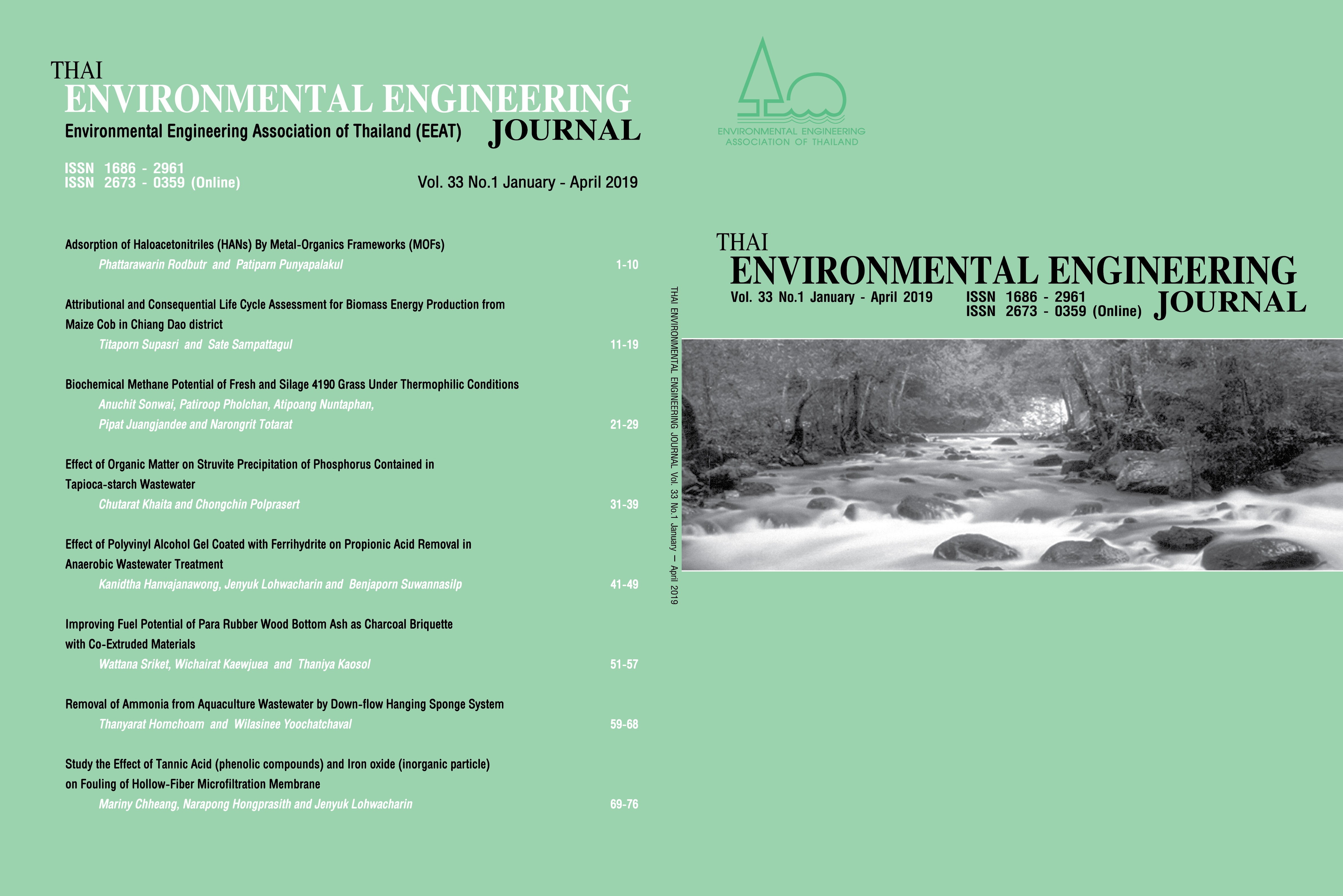Effect of Polyvinyl Alcohol Gel Coated with Ferrihydrite on Propionic Acid Removal in Anaerobic Wastewater Treatment
Main Article Content
Abstract
Propionic acid is a crucial factor that influences the efficiency of anaerobic wastewater treatment, because its accumulation in the process decreases the pH levels. Therefore, this study focused on an approach that can alleviate this inhibitory effect from propionic acid. Polyvinyl alcohol (PVA) have been used for encapsulating active microorganisms in cell immobilization technology. Using PVA gel coated with Fh (FhPVA) as a biocarrier in the system, propionic acid can be removed to enhance capability of microbes for converting volatile fatty acid (VFA) into methane gas and decrease an inhibitory effect from VFA accumulation in the system. The specific surface areas (SSA) of PVA and FhPVA were estimated employing the methylene blue dye adsorption with spectrophotometric analysis. The adsorption affinity of each type of the media were computed using SSA and the residual propionic acid concentration obtained from the experiment. The SSA were found to be 1.41 m2 g-1, 0.40 m2 g-1 for PVA and FhPVA, respectively. From the result, it can be assumed that the impregnation process results in pore blockages, so the surface area of FhPVA is apparently lower than PVA. In addition, the adsorption affinity of FhPVA towards propionic acid is much higher than PVA, which were 19.39 mg L-1m-2 and 5.29 mg L-1m-2, respectively. Lastly, this study is only the first step that illustrates the probability of using Fh for improving the efficiency of the anaerobic system, but further study is needed for discovering a better approach for coating Fh on the media.
Article Details
References
[2] Yoon, S.-H., 2015. Membrane bioreactor processes: principles and applications. CRC press.
[3] Chaikasem, S., Abeynayaka, A. and Visvanathan, C. 2014. Effect of polyvinyl alcohol hydrogel as a biocarrier on volatile fatty acids production of a two-stage thermophilic anaerobic membrane bioreactor. Bioresour. Technol. 168: 100-105.
[4] Zhao, J., Huggins, F. E., Feng, Z. and Huffman, G. P. 1994. Ferrihydrite: Surface structure and its effects on phase transformation. Clays and Clay Minerals 42(6): 737-746.
[5] Michel, F. M., Ehm, L., Antao, S. M., Lee, P. L., Chupas, P. J., Liu, G., Strongin, D. R., Schoonen, M. A., Phillips, B. L. and Parise, J. B. 2007. The structure of ferrihydrite, a nanocrystalline material. Science. 316(5832): 1726-1729.
[6] Gu, B., Schmitt, J., Chen, Z., Liang, L. and McCarthy, J. F. 1994. Adsorption and desorption of natural organic matter on iron oxide: mechanisms and models. Environ. Sci. Technol. 28(1): 38-46.
[7] Gu, Z., Fang, J. and Deng, B. 2005. Preparation and evaluation of GAC-based iron-containing adsorbents for arsenic removal. Environ. Sci. Technol. 39(10): 3833-3843.
[8] Nunes, C. A. and Guerreiro, M. C. 2011. Estimation of surface area and pore volume of activated carbons by methylene blue and iodine numbers. Química Nova 34(3): 472-476.
[9] Vilar, V. J., Botelho, C. M. and Boaventura, R. A. 2007. Methylene blue adsorption by algal biomass based materials: biosorbents characterization and process behaviour. J. Hazard. Mater. 147(1-2): 120-132.
[10] Yukselen, Y. and Kaya, A. 2008. Suitability of the methylene blue test for surface area, cation exchange capacity and swell potential determination of clayey soils. Eng. Geol. 102(1-2): 38-45.
[11] Bhushan Tewari, B. and Ostwald Thornton, C. 2010. Use of basic Methylene Blue Dye for specific surface area measurement of metal hexacyanoferrate (II) complexes. Revista de la Sociedad Química del Perú 76(4): 330-335.
[12] Choo, K. H., 2016. Method for producing an organic-inorganic hybrid sorbent by impregnating an oxide into nanopores of activated carbon and use thereof in water treatment. Google Patents.
[13] Park, H. S., Koduru, J. R., Choo, K. H. and Lee, B. 2015. Activated carbons impregnated with iron oxide nanoparticles for enhanced removal of bisphenol A and natural organic matter. J Hazard Mater 286: 315-324.


